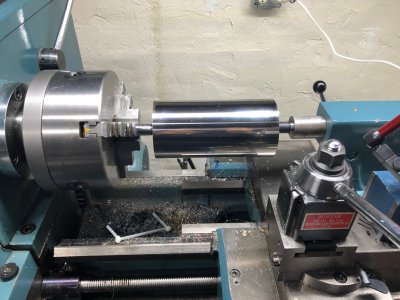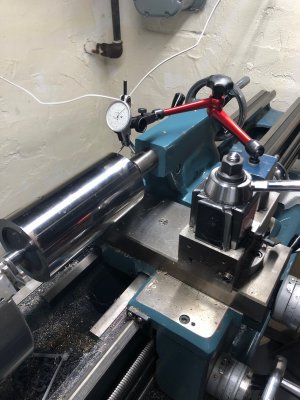- Joined
- Mar 26, 2018
- Messages
- 2,724
Wanted to perform a tailstock alignment on my lathe. Created a "dumbbell" test bar from 1" aluminum and rigged up a dog using some C-clamps, mini-vee blocks, and some scrap bar. Spindle center was turned in place from some barstock. I had a dead center in the tailstock. I've never done turning between centers but it seems straightforward endough.
It all started out ok, and I was taking some light wisper cuts on the lobe of the dumbbell and I started smelling this faint burning smell. Turned the lathe off and checked the chip pile for something smoldering, check the motor, and the belts. Everything was cold. I started the lathe up again and noticed the diameter I had just turned was wobbling off center. That's real strange... Then I touched the part - OUCH! Sucker is HOT! WTH!?
Well turns out I put a fair bit of pressure on the centers (on aluminum) with absolutely no oil on the dead center in the tailstock. I managed to friction weld my test bar to the dead center. Whoops!
Now I need to clean up the test bar and give it new centers and try this again. Is using a live center on the tailstock accurate enough for alignment? How might I clean up the dead center tip? I can get a set of real lathe dogs for $75 shipped (0.5"-2.5" - 5 pieces). Is this worthwhile? I have never needed one before but they might come in handy.
It all started out ok, and I was taking some light wisper cuts on the lobe of the dumbbell and I started smelling this faint burning smell. Turned the lathe off and checked the chip pile for something smoldering, check the motor, and the belts. Everything was cold. I started the lathe up again and noticed the diameter I had just turned was wobbling off center. That's real strange... Then I touched the part - OUCH! Sucker is HOT! WTH!?
Well turns out I put a fair bit of pressure on the centers (on aluminum) with absolutely no oil on the dead center in the tailstock. I managed to friction weld my test bar to the dead center. Whoops!
Now I need to clean up the test bar and give it new centers and try this again. Is using a live center on the tailstock accurate enough for alignment? How might I clean up the dead center tip? I can get a set of real lathe dogs for $75 shipped (0.5"-2.5" - 5 pieces). Is this worthwhile? I have never needed one before but they might come in handy.




